ISSN ONLINE(2278-8875) PRINT (2320-3765)
ISSN ONLINE(2278-8875) PRINT (2320-3765)
S.Gowri Mani Shankar1, Harsha anantwar2
|
| Related article at Pubmed, Scholar Google |
Visit for more related articles at International Journal of Advanced Research in Electrical, Electronics and Instrumentation Engineering
The biggest weakness of wind power energy is the lack of exact predictability on its generation. Perhaps even if other energy sources can be saved by using wind energy, the short term power variation must be secured by a conventional plant. The variations in the output of a large wind farm results in many integration issues. The uncertainty in the output of a large wind plant can be overcome by using fast acting dispatchable sources. The goal is to reach the smallest possible difference between actual wind power and forecasted wind power. In this paper a model, which optimizes the wind power energy by battery based energy storage system with the help of conventional and intelligent controllers, has been developed. This paper presents controlling methodologies for a battery based energy storage system in conjunction with PID and Fuzzy logic controller. The results may show that choosing of proper controller along with battery based energy storage system will give effective control over wind power. In order to overcome the drawbacks of the wind power, the use of energy storage as power buffer has investigated.
Keywords |
| Predictability, forecast, intelligent controllers, power buffer. |
INTRODUCTION |
| Wind energy at the present days attaining more reputation all around the world. Wind energy has adept the massive growth in last twenty years. Presently, five countries Germany, USA, India, Denmark, and Spain have more than 83%of international wind energy capacity in their nations. In modern times by the large production of wind power the United States settled as the world leader in mounted wind power capacity. The consumption of wind energy has turn into a tradition of about 3000 years, and the technology has converted very challenging. It comprises technical stuffs such as aerodynamics, Structural dynamics and mechanical as fine as electrical engineering [1]. It has been estimated that an extra 5000 megawatts of wind power will come operational within next five years at Pacific Northwest [2]. The changing nature of a wind farm yield gives several encounters for grid workers. The vagueness in the output of a wind farm can be overwhelmed with the application of fast performing dispatchable sources. This study is dedicated on an inquiry of possibility of spending energy storage battery with the mixture of energy controller with wind farm to advance the sureness of a wind farm output inside ±4%, 90% of the time [3]. The tenacity of this study is to determine the best energy controller amongst PID and fuzzy logic controller in union with battery based energy storage system to meet the forecasted wind farm production in ±4%, 90% of the time. |
A.Literature review |
| In the literature, there are investigations on the use of energy storage applied to a single wind turbine to overcome the variability of the output [4]-[6]. Research had aimed on the effectiveness of battery energy storage for improving the variability of wind farm output. The modeling and operation of energy storage for a 80MW and 50MW wind farm are identified in publications [7] and [8].Optimal control for a generic battery energy storage for use with large wind farms are presented in publications [9] and [10]. To overcome the drawbacks of the wind power, the usage of batteries as power barrier has been inspected for smoothening the power variations from large wind farms and use of batteries as primary and secondary control of the wind farm has been analyzed. The connection of one “wind farm – battery” unit on a test power system has been modeled. The system with and without the use of battery has been tested [11]. |
SYSTEM DESCRIPTION |
| The fig. 1 shows the block diagram of the proposed system. From the previous discussion, it is mentioned that, to overcome the fluctuations in wind power a battery storage system was connected in conjunction with energy controller. The wind power generated by wind turbine is supplied to the load. Due to the variation of wind, the generation of wind power may not be constant; it may be more production or less production than the required. It results in fluctuations.so as battery storage system is connected, if |
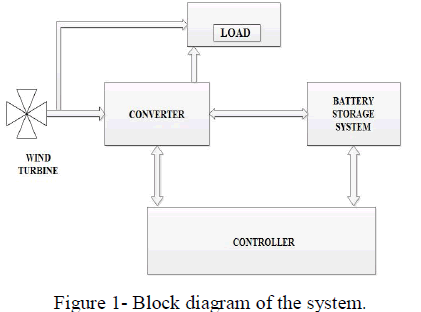 |
| generation of wind power is more than the required wind power then the excess wind power is stored by the battery .And if generation of wind power is less than the required wind power, the remaining power will be supplied by the battery to meet the load requirement. So if more power generation is there than the required, the battery storage system should charge by storing excess energy and if less power generation is there than the required, the battery should discharge by supplying stored energy. This charging and discharging of battery will be controlled by the energy converter which acts as bidirectional. The energy converter and battery storage system will be controlled by the controller which estimates the difference between actual and forecasted wind power. |
WIND POWER FORECASTING |
| The wind power forecasting represents to an estimation of the expected production of one or many wind turbines in the near future. Depending on the wind farm capacity, the production is often considered as available power from a certain wind farm (KW, MW, depends on nominal capacity). Forecasting of wind power can also be expressed in terms of energy, by assimilating power production over each time interval. The need of wind power forecasting is that in an electricity grid at every time consumption and generation must be balanced, if not we may get disturbances in power quality or supply. Wind power generation is a direct function of wind speed and, in contrast to predictable generation systems it is not easily dispatchable. Fluctuations in wind power generation require a great amount of attention. Balancing the variations in wind power generation with consumption is the key aspect associated to the optimal integration of that renewable energy into electricity grids. |
| Classification of wind power forecasting is of both kinds, they are: |
| Classification by unlike time scales. |
| Classification by the horizon of forecast. |
| Classification of wind forecast by different time scales: |
| Very short term forecast – corresponds to the time scale ranging from milliseconds to few minutes. These forecasts are used for turbine active control. |
| Short term forecast - corresponds to the time scale ranging from 48-72 hours. These forecasts are castoff for power system management or energy trading. |
| Long term forecast – corresponds to the time scale ranging from 5-7 days. These forecasts are used for planning and maintenance of wind farms, conventional power plants or transmission lines. |
| Classification of wind forecast by the horizon of forecast: |
| Physical forecast method – Forecasting of this type can be done by the equations of physics by the numerical methods. This model can run for two or four times a day using updated meteorological information. It consists of many sub models. Each sub model contains mathematical description. Knowledge of all sub models is necessary. It considers the physical considerations such as roughness, orography and obstacles etc… |
| Statistical forecast method – Forecasting of this type considers past data. It will calculate the relation between expected wind speed and actual wind power output from wind farm to estimate the wind power. It won’t use uses the power curve and local meteorology. These are self-calibrate and inherit any variations in roughness or wind resource to provide an advance forecast. |
| In physical forecast system, forecasting depends on generated and actual wind power, but in statistical forecast system directly depends on previous and present values. From the obtained result, Statistical forecast system is more effective than physical forecast system. Current and voltage responses are fast in statistical compared to physical system. Physical system is less efficient compared to statistical. The prediction accuracy also much better with statistical forecast system compared to physical forecast system. Thus results of statistical forecast system are considered for further discussion. |
IMPLIMENTATION OF PROPOSED MODEL WITH STATISTICAL FORECAST SYSTEM |
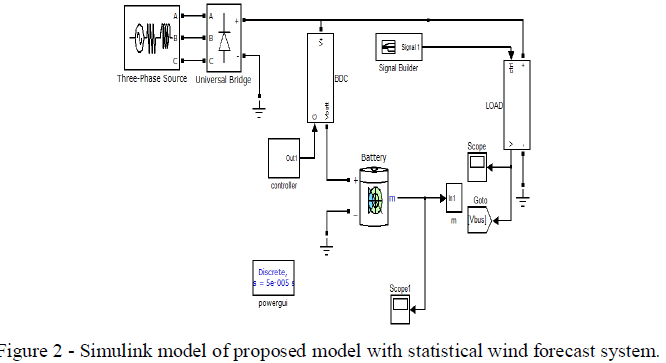 |
| The fig.2 shows the Simulink model of statistical wind forecast system. It is mentioned earlier that to deal with statistical system large amount of past data is required .It will establish the relation between historical values of power as well as historical and forecast values. Model parameters are established from a set of past available data and they are updated regularly during online operation. Almost it is same as physical forecast system, only the difference is with controller part. As we need to store the past data and update it regularly we require memory, this option is not there with PID controller, hence DSP based controller output is used. |
| In this system the three phase ac source represents the wind generator output, it is converted in to DC by rectifying with diode Circuit Bridge that can be implemented by universal bridge. Then it is connected to bidirectional DC/DC converter along with PID controller and energy storage battery. The bidirectional DC/DC converter which will control the direction of energy flow. During excess of power the converter should send power in to the storage system , so that time it should act as buck converter whereas during lack of power the converter should get power from the storage system that time converter should act as boost converter. |
| So the converter is selected, such that it should work as buck converter as well as boost converter. So the selected converter should work as buck and boost converter. Once it should send power and once it should receive power so the converter should be bidirectional. |
| The fig.3 shows the simulation result of statistical system. In this system, it is essential to know about its past and present data from statistics. The SOC graph shows the charging and discharging of battery while the current is in negative and rising slowly when SOC starts discharging and the voltage will rise according to the SOC. |
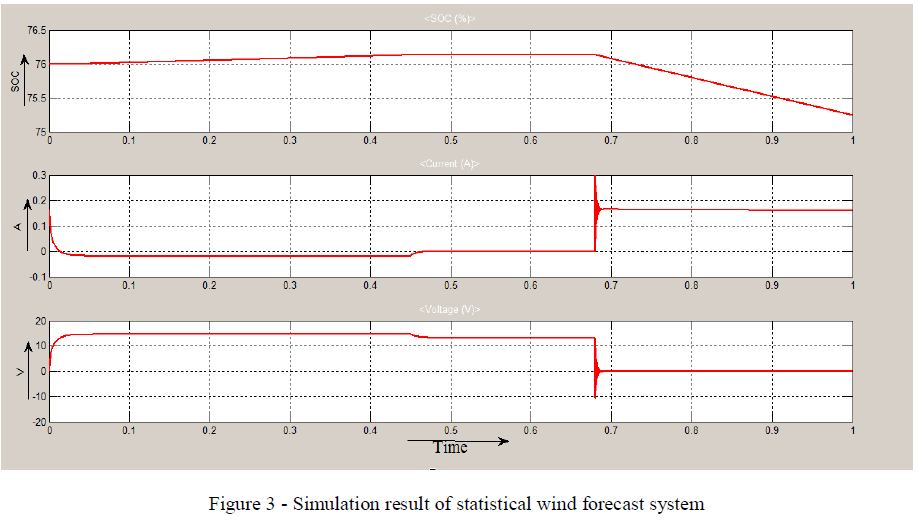 |
IMPLIMENTATION OF PROPOSED MODEL WITH FUZZY LOGIC CONTROLLER |
| Fuzzy logic idea is similar to that of human being’s feeling and inference process. Fuzzy logic control is a range-to-point or range-to-range control strategy. The output of a fuzzy controller is obtained from fuzzifications of both inputs and outputs using the associated membership functions. Computers can only understand either '0' or '1', and 'HIGH' or 'LOW'. That data is called crisp or classic data which can be processed by all the machines. From 1980s many fuzzy implementations have been done, including the applications in, automatic control ,industrial manufacturing, in Industrial Applications automobile production, banks, libraries , hospitals, and academic education. The conversions, both the input and the output must be converted from crisp data to fuzzy data. Further to begin the fuzzy inference process, need to combine the Membership Functions with the control rules to obtain the control output, and arrange those outputs into a table called the lookup table. For fuzzy inference process the control rule is the core, and that rules are directly related to a human being’s intuition and feeling. Later, that control output must be converted from the linguistic variable to the crisp variable and output to the control operator. |
| A typical architecture of fuzzy logic control is comprises of Fuzzification, a fuzzy rule base, inference engine, and Defuzzification. The fuzzification can be done by fuzzifier, which involves transforming of crisp measured data into suitable linguistic values. The empirical knowledge of the operation of the Process of the domain experts can be stored by the fuzzy rule base. The inference engine is the kernel of a fuzzy logic controller, it has the ability of simulating human decision making by performing approximate reasoning to achieve a desired control strategy. The defuzzification can be done by defuzzifier, which involves transforming back of linguistic variable to crisp data. |
| The fig. 4 shows the implementation of proposed model with fuzzy logic controller. The reference port gives the reference wind power and it is compared with the actual wind power. The error which is the difference between actual and reference wind power is the input for fuzzy logic controller. In fuzzy logic controller this crisp data will be converted in to membership functions by fuzzification process. Later the fuzzy interference process combine membership functions with the control rules (fuzzy rules) to derive the fuzzy output. Then defuzzification will be carried out by defuzzifier. The output of fuzzy controller is amplified by using PI controller. To limit the output of PI controller, saturation block is used, it stables the system. |
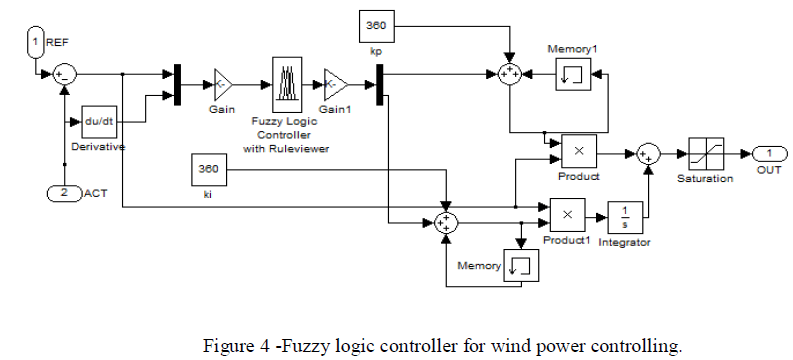 |
| The below Fig.5 shows the simulation result of fuzzy logic controller. As at step signal the initial value is 100 watts and at 0.1 sec of time it is 70 watts mentioned at the time of simulation, the graph represents the same. The graph clearly shows that initially it is reaching the required value. This is the advantage of fuzzy logic controller which acts very fast. This shows the quick response of fuzzy logic controller. |
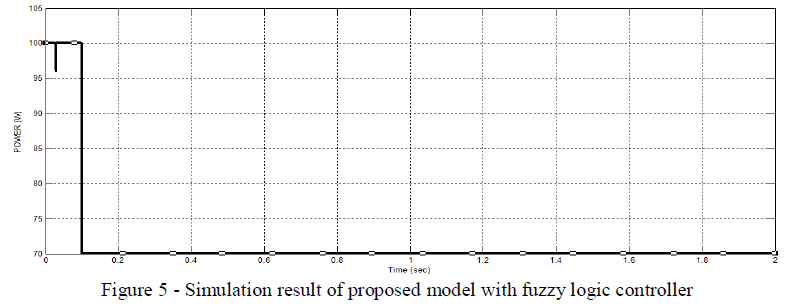 |
COMPARISION OF PID AND FUZZY LOGIC CONTROLLER WITH PROPOSED MODEL |
| The fig. 6 shows the comparison of fuzzy and PID controller with the proposed model. The transfer function represents the generator and battery system .It is represented in transfer function by using thevinens theorem. The performance of PID controller and fuzzy controller are compared by the following setting. |
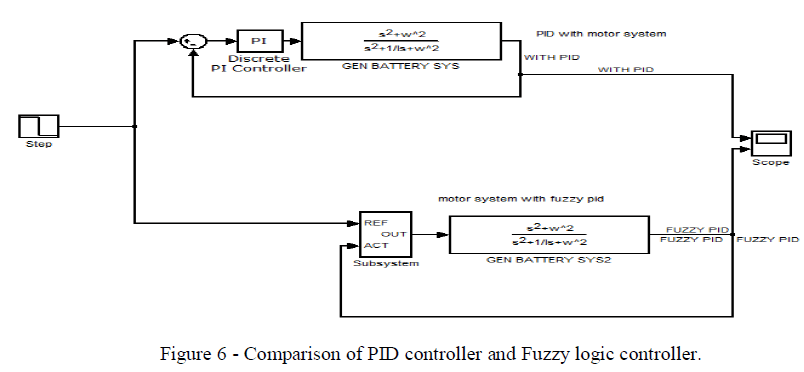 |
| The transfer function (TFS) for generator battery system is, |
 |
| The below fig.7 shows the comparison of fuzzy and PID controller simulation graphs. From the comparison graph it is clearly observed that Fuzzy controller is fast responsive than the PID controller. For PID controller it has taken some time to reach the required value whereas for fuzzy logic controller initially reached the required value. This shows that Fuzzy logic controller having faster response than PID controller. |
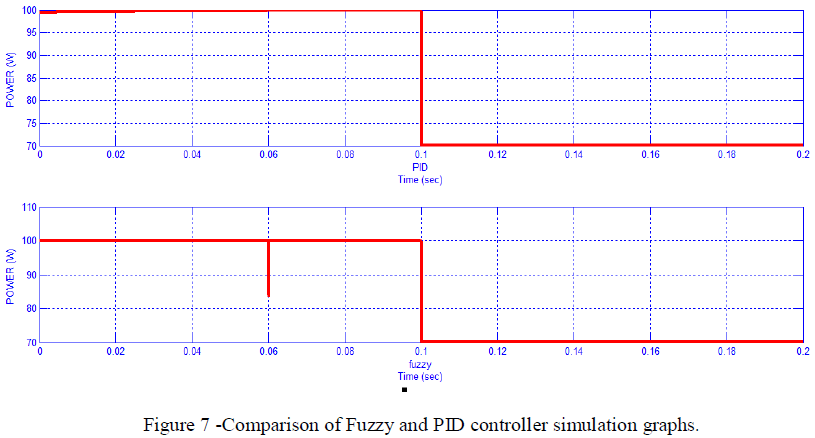 |
COMPARITIVE STUDY |
| Based on the simulation results obtained for both physical and statistical based forecast model it can be concluded that in physical forecast system it depends on bus voltage and load but in statistical forecast system directly depends on previous and present values. Current and voltage responses are fast in statistical compared to physical system. Physical system is less efficient compared to statistical. The prediction accuracy also much better with statistical compared to physical system. And from the comparison of both PID and FUZZY controllers with the proposed model, it can be concluded that fuzzy controller is very faster than PID controller. It has better controllability, very robust, easily modified, very quick response. PID controller is less efficient compared to fuzzy controller. |
CONCLUSION |
| For the proposed system, investigations have been done to get the optimization of energy storage with the PID controller and fuzzy controller.. And the results are presented in Fig.7. It can be concluded that fuzzy controller system is more effective than the PID controller, that has been mentioned in comparative study .The final work is based on the implementation of fuzzy and PID controllers along with hybrid energy storage system to get the best result. |
FUTURE WORK |
| Simulation of proposed system with Fuzzy controller along with hybrid energy storage system. |
| Simulation of proposed system with PID controller along with hybrid energy storage system. |
| Assessment and study of the results. |
References |
|